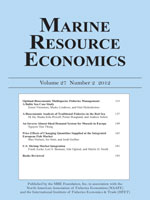We assess cod, herring, and sprat fisheries in the Baltic Sea under different environmental conditions using a bioeconomic model with simple predation functions. We compare the status quo fishing policy to an optimal policy under two different salinity conditions, which have a link to climate change. The fishery of these species is not at the most profitable level. If the fishing mortalities are lower, economic return will be greater in the long run. A lower fishing mortality for cod, which allows time for individuals to grow and achieve a higher economic value and reproduction potential, would result in the recovery of the cod stock. Under a high salinity level, which leads to better conditions for cod recruitment, the cod stock has a better chance to recover even without a decrease in fishing mortality. Therefore, fishery management is even more important under conditions of low salinity, which are likely to prevail in the future due to changing climate.
JEL Classification Codes: Q22, Q54, Q57





